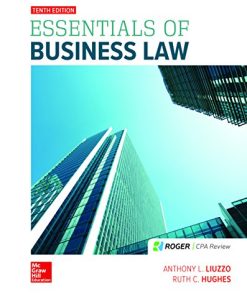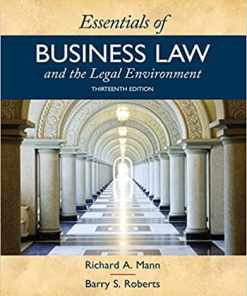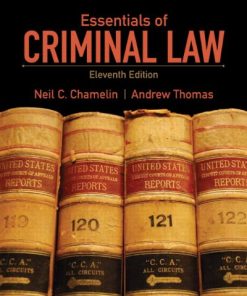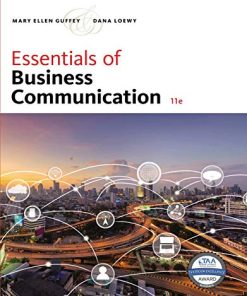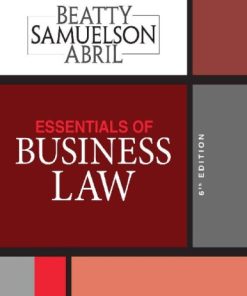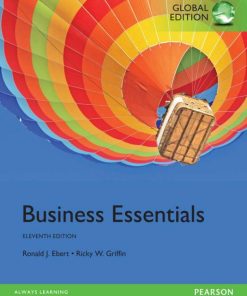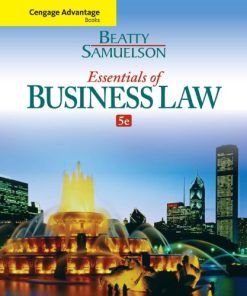Essentials of Business Law 11th Edition by Anthony Liuzzo 1264126506 9781264126507
$50.00 Original price was: $50.00.$25.00Current price is: $25.00.
Essentials of Business Law 11th Edition by Anthony Liuzzo – Ebook PDF Instant Download/DeliveryISBN: 1264126506, 9781264126507
Full download Essentials of Business Law 11th Edition after payment.
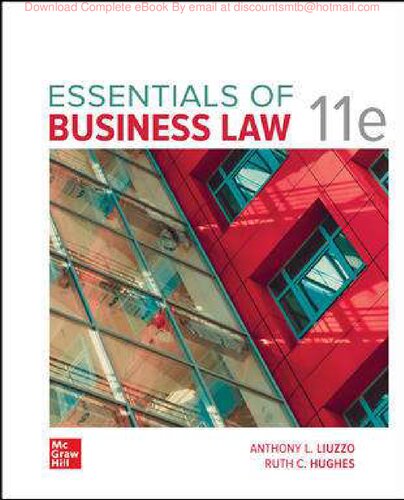
Product details:
ISBN-10 : 1264126506
ISBN-13 : 9781264126507
Author : Anthony Liuzzo
The new, eleventh edition of the Essentials of Business Law program is a practical, concise, and broad-based introduction to the vibrant field of business law. While continuing to offer all of the features that have made the ten prior editions successful, this new edition includes a chapter on the areas of law affected by social media, updated content, and enhanced support materials. Both the traditional areas of law, such as contracts and property, and the emerging areas of law, such as e-commerce and environmental, are covered in short, informative chapters written to capture the essence of each topic. The objective of the text throughout its coverage is ease of use, ease of teaching, ease of assessment, and ease of understanding. It has been developed for those seeking a more fundamental overview of the concepts and principles that are vital to the understanding of business law.
Essentials of Business Law 11th Table of contents:
Chapter 1: Our System of Law
Part 1: Introduction to Law
Chapter 1 Introduction
1.1 The Law in Our World
1.2 Applications of Law
Personal Applications of Law
Business Applications of Law
Government Applications of Law
1.3 Sources of Law
Constitutional Law
Executive Orders
Treaties
Common Law
Precedent
Case Law
Statutory Law
Administrative Law
1.4 Uniform Commercial Code
1.5 Classification of Laws
1.6 Moral Law
1.7 A System of Courts
Court Jurisdiction
Federal Courts
State Courts
Chapter Summary
Chapter One Assessment
Chapter 2: Ethics and the Law
Chapter 2 Introduction
2.1 Unethical Behavior in Our World
2.2 Morals, Ethics, and Values
2.3 The Relationship between Law and Ethics
2.4 Ethical Reasoning and Responses
Approaches to Ethical Reasoning
Responses of Business Firms
Responses of Educational Institutions
Responses of Governments
Responses of Trade and Professional Associations
2.5 Ways to Ensure Ethical Practices
Corporate Responsibility
Codes of Ethics
Whistleblowing
Integration of Ethics into Business and Government
Chapter Summary
Chapter Two Assessment
Chapter 3: Criminal Law
Chapter 3 Introduction
3.1 Crime
3.2 Classification of Crimes
Treason
Felony
Misdemeanor
3.3 Crimes in the Business World
White-Collar Crime
Securities Fraud
Arson
Larceny/ROBBERY/BURGLARY
Bribery
False Pretenses
Forgery
Perjury
Embezzlement
Extortion
Other Business-Related Crimes
Chapter Summary
Chapter Three Assessment
Chapter 4: Tort Law
Chapter 4 Introduction
4.1 The Nature of Torts
4.2 Defamation
4.3 Libel and Slander
Characteristics of Libel
Characteristics of Slander
Trade Libel
Humor and Slander
4.4 Defenses to Defamation
4.5 Nuisance
4.6 Conversion
4.7 Negligence
Unavoidable Accident
The “Reasonable Person”
Kinds of Negligence
4.8 Liability
Vicarious Liability
Strict Liability
Chapter Summary
Chapter Four Assessment
Chapter 5: Constitutional Law
Chapter 5 Introduction
5.1 The United States Constitution
Constitutional Powers
Constitutional Amendments
Judicial Review
The Doctrine of Preemption
5.2 The Commerce Clause, the Full Faith and Credit Clause, and the Supremacy Clause
Article 1, Section 8, Clause 3: The Commerce Clause
Article IV, Section 1: The Full Faith and Credit Clause
Article VI, Clause 2: The Supremacy Clause
5.3 The First Amendment
The Establishment and Free Exercise Clauses Relating to Religion
Freedom of Speech
Freedom of the Press
5.4 The Second Amendment
5.5 The Fourth Amendment
5.6 The Fifth Amendment
5.7 The Eighth Amendment
5.8 The Fourteenth Amendment
5.9 The Sixteenth Amendment
Chapter Summary
Chapter Five Assessment
Chapter 6: Administrative Law
Chapter 6 Introduction
6.1 Administrative Agencies
6.2 Organization of Governments
Legislative Branch of Government
Executive Branch of Government
Judicial Branch of Government
6.3 Functions of Administrative Agencies
Regulating Conduct
Fulfilling Government Requirements
Disbursing Benefits
Providing Goods and Services
6.4 Why and How an Administrative Agency is Formed
6.5 Similarities and Differences Between Administrative Agencies and Governments
Similarities
Differences
6.6 Criticism of Administrative Agencies
Chapter Summary
Chapter Six Assessment
Chapter 7: Introduction to Contracts
Part 2: Contracts
Chapter 7 Introduction
7.1 The Nature of a Contract
7.2 Sources of Contract Law
Agreements that Result in Contracts
7.3 Purpose of a Contract
7.4 Elements of an Enforceable Contract
Offer and Acceptance
Mutual Agreement
Consideration
Competent Parties
Legality of Purpose
Proper form
7.5 Kinds of Contracts
Oral Contracts
Written Contracts
Express Contracts
Implied Contracts
Formal Contracts
Simple Contracts
Entire Contracts
Divisible Contracts
7.6 Status of Contracts
Executory Contracts
Executed Contracts
7.7 Enforceability of Contracts
Valid Contracts
Void Contracts
Voidable Contracts
7.8 Smart Contracts
Chapter Summary
Chapter Seven Assessment
Chapter 8: Offer and Acceptance
Chapter 8 Introduction
8.1 Reaching Agreement
8.2 Requirements for a Valid Offer
An Offer Must be Definite and Certain
An Offer Must be Communicated
An Offer Must Intend an Enforceable Obligation
8.3 Bids, Advertising, and Public Offers
Bids and Estimates
Advertising
Public Offers
8.4 Requirements for a Valid Acceptance
An Acceptance Must be Communicated
An Acceptance Must be Unconditional
8.5 Termination of an Offer
Termination by Lapse of Time
Termination by Revocation
Termination by Rejection
Termination by Death or Incapacity
Termination by Destruction or Illegality
Chapter Summary
Chapter Eight Assessment
Chapter 9: Mutual Agreement
Chapter 9 Introduction
9.1 Defective Agreements
9.2 Fraud
9.3 Misrepresentation
9.4 Mistake
9.5 Undue Influence
9.6 Duress
9.7 Contracts of Adhesion
9.8 Unconscionable Contracts
Chapter Summary
Chapter Nine Assessment
Chapter 10: Consideration
Chapter 10 Introduction
10.1 The Nature of Consideration
10.2 Characteristics of Valid Consideration
Legality of Consideration
Adequacy of Consideration
Possibility of Performance
10.3 Kinds of Valid Consideration
A Promise for a Promise
A Promise of Forbearance
A Pledge or Subscription
10.4 Consideration and the Uniform Commercial Code
10.5 General Release
10.6 Agreements that Lack Consideration
Barren Promises
Gratuitous Promises
Illusory Promises
Agreements Supported by Moral Consideration
Agreements Supported by Past Consideration
Chapter Summary
Chapter Ten Assessment
Chapter 11: Competent Parties
Chapter 11 Introduction
11.1 The Capacity to Contract
11.2 Minors’ Contracts
Avoidance of Minors’ Contracts
Ratification of Minors’ Contracts
Disaffirmance of Minors’ Contracts
Minors’ Enforceable Contracts
11.3 Liability for Minors’ Torts and Crimes
11.4 Contracts of the Mentally Incompetent
Contracts of Persons Affected by Drugs or Alcohol
Chapter Summary
Chapter Eleven Assessment
Chapter 12: Legal Purpose of Contracts
Chapter 12 Introduction
12.1 Legality and the Public Interest
Classification of Illegal Agreements
Effect of Illegality
12.2 Agreements in Violation of Statutes
Agreements Made on Sundays or Legal Holidays
Gambling and Wagering Agreements
Usurious Agreements
Unlicensed Transactions
12.3 Agreements against Public Policy
Agreements that Obstruct or Pervert Justice
Agreements that Restrain Marriage
Agreements that Interfere with Public Service
Agreements to Defraud Creditors and other Persons
Exculpatory Clauses
12.4 Illegal Restraints of Trade
Sherman Antitrust Act
Robinson-Patman Act
12.5 Legal Restraints of Trade
Government-Granted Monopolies
Private Franchises
Zoning Regulations
Environmental and Safety Regulations
Chapter Summary
Chapter Tweleve Assessment
Chapter 13: Form of Contracts
Chapter 13 Introduction
13.1 The Requirement of Proper Form
When Contracts Should be in Writing
13.2 The Parol Evidence Rule
13.3 The Statute of Frauds
13.4 Types of Contracts That Must Be in Writing
Agreements by an Executor or Administrator to Pay the Debts of a Deceased Person
Agreements to Answer for the Debts of Another
Agreements that Cannot be Completed in Less than One Year
Agreements Made in Contemplation of Marriage
Agreements to Sell Any Interest in Real Property
Agreements to Sell Personal Property for $500 or More
13.5 Information Included in a Written Contract
Chapter Summary
Chapter Thirteen Assessment
Chapter 14: Operation of Contracts
Chapter 14 Introduction
14.1 Contracts Involving Third Parties
14.2 Rights of Third Parties
Third-Party Beneficiaries
Incidental Beneficiaries
14.3 Assignment of Rights
Form of Assignment
Notice of Assignment
Rights that may be Transferred
The Assignor’s Guaranty
14.4 Contracts That May Not Be Assigned
Contracts that Include Assignment Restrictions
Contracts for which Assignments are Prohibited by Law or Public Policy
Contracts that Require Personal Services
14.5 Delegation of Duties
14.6 Assignment and Delegation by Law
Death of a Contracting Party
Bankruptcy of a Contracting Party
14.7 Novation
Chapter Summary
Chapter Fourteen Assessment
Chapter 15: Discharge of Contracts
Chapter 15 Introduction
15.1 Termination of Contracts
15.2 Termination by Agreement
15.3 Termination by Performance
Substantial Performance
Performance by Payment of Money
Tender and its Effect
15.4 Termination by Impossibility of Performance
Personal-Service Contracts
Frustration of Purpose
15.5 Termination by Alteration
15.6 Termination by Operation of Law
15.7 Termination by Breach of Contract
Anticipatory Breach
Breach Resulting from a Deliberate or Negligent Act
Failure to Perform an Obligation
15.8 Termination to Protect a Consumer
15.9 Remedies for Breach of Contract
PUNITIVE DAMAGES
LIQUIDATED dAMAGES CLAUSE
Specific Performance
Restraining Order or Injunction
Chapter Summary
Chapter Fifteen Assessment
Chapter 16: Transfer of Title
Part 3: Sales, Agency, and Business Organizations
Chapter 16 Introduction
16.1 Title
The Right of Ownership
16.2 Kinds of Property
Real Property
Personal Property
16.3 How Title Passes
Bill of Sale
Bill of Lading
Warehouse Receipt
16.4 When Title Passes
Intent
Specific Time
16.5 Conditional Sales
Conditions Precedent
Conditions Subsequent
16.6 Lost and Stolen Goods
16.7 Transfer of Title by Estoppel
Examples of Estoppel
16.8 Sales by Persons Having Possession
Sales by Persons Having Rightful Possession
Sales by Persons Having Wrongful Possession
16.9 Transfer of Title to Fungible Goods
Chapter Summary
Chapter Sixteen Assessment
Chapter 17: Sales
Chapter 17 Introduction
17.1 The Law of Sales
17.2 Contracts for Sale Versus Contracts to Sell
17.3 Oral, Written, Express, and Implied Contracts
17.4 Entire and Divisible Sales Contracts
17.5 Contracts for Labor and Materials
17.6 Trial Periods and Returns
Contract for Sale with Right of Return
Sale on Approval
Sale or Return
17.7 Other Kinds of Sales
Auction Sales
Conditional Sales
Consignment Sales
17.8 Delivery
Sales FOB Shipping Point
Sales FOB Destination
17.9 Remedies for Breach of Sales Contracts
Sellers’ Remedies
Buyers’ Remedies
Chapter Summary
Chapter Seventeen Assessment
Chapter 18: Warranties
Chapter 18 Introduction
18.1 Protecting Consumers and Third Parties
18.2 The Law of Warranties
18.3 Express Warranties
Express Warranty by Promise
Express Warranty by Description, Sample, or Model
The Timing of the Express Warranty
The Effect of Sellers’ “Puffing”
Disclaimers of Express Warranties
18.4 Implied Warranties
Title
Quality
Disclaimers of Implied Warranties
18.5 Magnuson-Moss Warranty Legislation
Provisions of Magnuson-Moss
Distinction Between Full and Limited Warranty
Remedies
Lemon Laws
Chapter Summary
Chapter Eighteen Assessment
Chapter 19: Agency
Chapter 19 Introduction
19.1 Principal–agent Relationships
Who May Appoint an Agent
Who May Be Appointed as an Agent
19.2 Classes of Agents
General Agent
Special Agent
19.3 Creation of Agency
Agency by Agreement
Agency by Ratification
Agency by Necessity
Agency by Operation of Law
19.4 Authority of an Agent
Express or Implied Authority
Apparent Authority
Agent’s Torts and Crimes
19.5 Duties of Agents, Principals, and Third Parties
Duties of Agent to Principal
Duties of Principal to Agent
Duties of Principal and Third Party to Each Other
Duties of Agent and Third Party to Each Other
19.6 Termination of Agency
19.7 Differences Between Principal–agent and Employer–Employee Relationships
Chapter Summary
Chapter Nineteen Assessment
Chapter 20: Business Organizations
Chapter 20 Introduction
20.1 Organizational Forms
20.2 Sole Proprietorship
Advantages of a Sole Proprietorship
Disadvantages of a Sole Proprietorship
20.3 Partnership
Advantages of a Partnership
Disadvantages of a Partnership
Limited Partnership
Limited Liability Partnership
20.4 Corporation
Advantages of a Corporation
Disadvantages of a Corporation
Subchapter S Corporation
Corporate Directors and Officers
Fiduciary Responsibility
20.5 Limited Liability Company
Advantages of a Limited Liability Company
Disadvantages of a Limited Liability Company
20.6 Other Organizational Forms
Chapter Summary
Chapter Twenty Assessment
Chapter 21: Bankruptcy
Chapter 21 Introduction
21.1 Insolvency and Default
21.2 Creditors Rights
21.3 The Law of Bankruptcy
21.4 Chapter 7 of the Federal Bankruptcy Law
21.5 Chapter 13 of the Federal Bankruptcy Law
21.6 Chapters 9, 11, 12, and 15 of the Federal Bankruptcy Law
Chapter 9
Chapter 11
Chapter 12
Chapter 15
Chapter Summary
Chapter Twenty-One Assessment
Chapter 22: Introduction to Commercial Paper
Part 4: Commercial Paper
Chapter 22 Introduction
22.1 Characteristics of Commercial Paper
Presumption of Consideration
Negotiability Versus Assignability
22.2 Kinds of Commercial Paper
Promises to Pay
Orders to Pay
The Meaning of “Pay to the Order of”
22.3 Parties to Commercial Paper
22.4 Essentials for Negotiability of Commercial Paper
It Must Be in Writing and Signed by the Maker or Drawer
It Must Contain an Unconditional Promise or Order to Pay a Definite Sum in Money
It Must Be Payable on Demand or at a Definite Time
It Must Be Payable to Order, to Bearer, or to Cash
A Draft or Check Must Name or Indicate the Drawee with Reasonable Certainty
22.5 Nonessentials for Negotiability of Commercial Paper
22.6 Checks
Relationship Between Bank and Depositor
Payment of Checks
The Check Clearing for the 21st Century Act
Certified Checks
Cashier’s Checks
Traveler’s Checks
Money Orders
Bad Checks
Forged and Raised Checks
Postdated Checks
Stopping Payment on Checks
22.7 Electronic Funds Transfer Systems
Applications of Electronic Funds Transfer Systems
The Electronic Funds Transfer Act
Chapter Summary
Chapter Twenty-Two Assessment
Chapter 23: Transfer and Discharge of Commercial Paper
Chapter 23 Introduction
23.1 Endorsing Commercial Paper
23.2 Kinds of Endorsements
Blank Endorsement
Special Endorsement
Restrictive Endorsement
Qualified Endorsement
23.3 Obligations, Warranties, and Discharge of Endorsers
23.4 Holder in Due Course
23.5 Defenses against Payment of Commercial Paper
Personal Defenses
Real Defenses
23.6 Presentment of Commercial Paper
23.7 Dishonor of Commercial Paper
Chapter Summary
Chapter Twenty-Three Assessment
Chapter 24: Real and Personal Property
Part 5: Property
Chapter 24 Introduction
24.1 Characteristics of Property
24.2 Distinction between Real and Personal Property
Real Property
Personal Property
Real Property Can Become Personal Property
Personal Property Can Become Real Property
24.3 Acquiring Title to Personal Property
Finding Lost Personal Property
Abandoned Property
Gifts
Accession
24.4 Ownership of Real or Personal Property
Severalty Ownership
Multiple Ownership
24.5 Real Property
Land
Buildings and Fixtures
Rights in Land other than Ownership
24.6 Interests in Real Property
Freehold Estates
Leasehold Estates
24.7 Transfer of Real Property
Types of Deeds
Delivery and Recording of Deeds
Other Transfers of Real Property
Chapter Summary
Chapter Twenty-Four Assessment
Chapter 25: Bailments
Chapter 25 Introduction
25.1 Bailment Defined
25.2 Characteristics of Bailments
Bailment Created by Possession of Goods
Bailee Must Intend to Possess Goods
Bailee Must Return Identical Goods
Termination of Bailments
25.3 Kinds of Bailments and Care during Custody
Bailments for the Sole Benefit of the Bailee
Bailments for the Sole Benefit of the Bailor
Mutual-Benefit Bailments
Constructive Bailments
Chapter Summary
Chapter Twenty-Five Assessment
Chapter 26: Landlord–Tenant Relations
Chapter 26 Introduction
26.1 The Landlord–Tenant Relationship
The Difference Between a Lease and a License
Essential Elements of the Landlord–Tenant Relationship
The Lease is the Basis of the Relationship
26.2 Types of Tenant Interests in Real Property
Periodic Tenancy
Tenancy for Years
Tenancy at Will
Tenancy at Sufferance
26.3 Rights and Duties of the Parties
Landlord’s Warranty of Habitability
Landlord’s Right to Rent, to Regain Possession, to Evict, and to Retain a Tenant’s Security Deposit
Landlord’s Right to Keep Fixtures and Permanent Improvements
Landlord’s Duty to Mitigate Damages
Tenant’s Right to Quiet Enjoyment
Tenant’s Right to Acquire and Retain Possession
Tenant’s Right to Assign or Sublease
26.4 Termination of Leases
Lease Expiration
Tenant’s Abandonment
Termination by Forfeiture (Breach)
26.5 Tort Liability
Chapter Summary
Chapter Twenty-Six Assessment
Chapter 27: Wills, Intestacy, and Trusts
Chapter 27 Introduction
27.1 The Purpose of a Will
27.2 The Language of Wills
27.3 Types of Gifts under Wills
27.4 Requirements of a Valid Will
Requirement of Writing
Requirement of Witnesses
Testamentary Capacity
Undue Influence
27.5 Revising and Revoking Wills
Revisions
Revocations
27.6 Intestacy
27.7 Trusts
Types of Trusts
The Role of the Trustee
Chapter Summary
Chapter Twenty-Seven Assessment
Chapter 28: Intellectual Property
Part 6: Business and Technology
Chapter 28 Introduction
28.1 Intellectual Property Defined
28.2 Trade Secrets
Protecting Trade Secrets
28.3 Application of Trade Secret Law to Computer Software
28.4 Trademarks
Trade Dress
How Trademarks are Lost
Protecting a Trademark
28.5 Application of Trademark Law to Cyberspace
Domain Names
28.6 Copyrights
Fair Use
28.7 Application of Copyright Law to Software and Cyberspace
28.8 Patents
28.9 Application of Patent Law to Computer Hardware and Software
Design Patents
Chapter Summary
Chapter Twenty-Eight Assessment
Chapter 29: Computer Privacy and Speech
Chapter 29 Introduction
29.1 Computer Privacy
Cookies
Electronic Mail
Data Privacy
29.2 Computer Crime
29.3 Computer Crime Legislation
The Electronic Communications Privacy Act
The USA Patriot Act
The Computer Fraud and Abuse Act
The Electronic Funds Transfer Act
General Criminal Law
Computer Gambling
29.4 Computer Speech
Harmful Speech
Liability of an Internet Service Provider
Obscenity
Spam
29.5 Advertising on the Web
Chapter Summary
Chapter Twenty-Nine Assessment
Chapter 30: Social Media and the Law
Chapter 30 Introduction
30.1 Social Media
30.2 Privacy in Social Media
Employer Access and Monitoring
Use in Employment Decisions
Evidence in Civil Trials
30.3 Crime and Social Media
Cyberstalking
Identity Theft and Fraud
30.4 Social Media and Speech
Defamatory and Offensive Speech
Intellectual Property Infringement
Deceptive Advertising
30.5 Emerging Issues in Social Media
Determining Creditworthiness
Securities Law Disclosure on Social Media
REMOVAL OF SOCIAL MEDIA ACCOUNTS
Chapter Summary
Chapter Thirty Assessment
Chapter 31: Conducting Business in Cyberspace
Chapter 31 Introduction
31.1 Business, the Internet, and Blockchain
31.2 Selling Securities on the Web
Securities Act of 1933
Securities Exchange Act of 1934
Insider Trading
Recent Trends in Financial Regulations
31.3 Selling Entertainment on the Web
The Digital Millennium Copyright Act
31.4 Entering Into Contracts on the Web
Accepting Offers on the Web
Contracts of Adhesion on the Web
Electronic Signatures
31.5 Settling Disputes in Cyberspace
31.6 Paying Taxes on Internet Sales
Taxing Internet Access Services
Chapter Summary
Chapter Thirty-One Assessment
Chapter 32: The Employer–Employee Relationship
Part 7: Legal Environment of Business
Chapter 32 Introduction
32.1 Duties of Employer and Employee to Each Other
32.2 Employees versus Independent Contractors
Independent Contractors
The Internal Revenue Service Test
32.3 The Doctrine of Employment at Will
32.4 Employment Contracts
32.5 Employee Handbooks
32.6 Employee References
Invasion of Privacy
Defamation
Negligent Misrepresentation
32.7 Fair Labor Standards Act of 1938
Chapter Summary
Chapter Thirty-Two Assessment
Chapter 33: Employment Law
Chapter 33 Introduction
33.1 Worker Safety and Health
Workers’ Compensation
Occupational Safety and Health Act
33.2 Discrimination in Employment
The Civil Rights Act of 1964
The Equal Pay Act of 1963
The Age Discrimination in Employment Act
The Pregnancy Discrimination Act
The Americans with Disabilities Act
The Civil Rights Act of 1991
Sexual Harassment
33.3 Labor Unions
Rights of Employees
Rights of the Union
Rights of the Employer
33.4 Additional Employee Rights
Family and Medical Leave Act
Unemployment Benefits
Chapter Summary
Chapter Thirty-Three Assessment
Chapter 34: Product Liability
Chapter 34 Introduction
34.1 Product Liability and Tort Law
34.2 Bases for Product Liability Injury Claims
Product Flaw
Failure to Warn
Design Defect
34.3 Who Can be Held Liable for Product-Related Injuries?
34.4 Strict Liability
34.5 Product Safety
34.6 Drugs
34.7 Consumer Products
34.8 Tobacco
34.9 Automobiles
Chapter Summary
Chapter Thirty-Four Assessment
Chapter 35: Professionals’ Liability
Chapter 35 Introduction
35.1 Professionals
35.2 Malpractice
35.3 Elements of Malpractice
35.4 Liability for Professional Malpractice
Liability of Health Care Providers
Liability of Accountants
Liability of Financial Planners
Liability of Architects and Engineers
Liability of Attorneys
Liability of Insurance Agents and Brokers
Other Professionals’ Liability
35.5 Reducing Professionals’ Risk of Liability
Chapter Summary
Chapter Thirty-Five Assessment
Chapter 36: International Business Law
Chapter 36 Introduction
36.1 Global Business
36.2 What Is International Law?
Sources of International Law
36.3 Applying Other Countries’ Laws—The Doctrine of Comity
36.4 International Trade Institutions
The World Trade Organization
The International Monetary Fund
The World Bank
Regional Trade Organizations and Agreements
36.5 The International Legal Environment
Trade Sanctions and Embargoes
Export and Import Controls
Governmental Actions
Boycotts
36.6 Doing Business in Foreign Countries
The Foreign Corrupt Practices Act
Contracts for the International Sale of Goods
Foreign Sovereign Immunities Act
International Treatment of Bankruptcies
36.7 International Law and Intellectual Property
Copyrights
Patents
Trademarks
Chapter Summary
Chapter Thirty-Six Assessment
Chapter 37: Business and the Environment
Chapter 37 Introduction
37.1 The Development of Environmental Protection
37.2 Government’s Regulation over Itself
37.3 Government Regulation of Business
37.4 Major Federal Legislation Protecting the Environment
The Clean Air Act
The Clean Water Act
Superfund
37.5 Lawsuits by Private Citizens
Negligence
Nuisance
Trespass
37.6 Types of Pollution
Noise Pollution
Pesticide Control
Solid Waste Disposal
Toxic Substance Disposal
Natural Resource Conservation
Acid Rain
37.7 A Changing Global Environment
The Greenhouse Effect
Destruction of Rain Forests
Destruction of the Ozone Layer
37.8 Other Environmental Issues
Biodiversity
Ocean Pollution
Space Pollution
Overpopulation
Chapter Summary
Chapter Thirty-Seven Assessment
Chapter 38: Health Care Law
Chapter 38 Introduction
38.1 Introduction
38.2 Advance Directives
Living Wills
Durable Power of Attorney for Health Care
Matters Covered by Advance Directives
38.3 Types of Medical Insurance
Community-Based Insurance
Major Medical
Commercial Insurance
Self-Insurance
Health Maintenance Organization
Medicare
Medicaid
38.4 Health-Related Employee Benefits
Medical Insurance
Family Plans
Disability Insurance
Dental Insurance
Vision Insurance
Group Life Insurance
38.5 State and Federal Regulation of Health Care Insurance
38.6 The Health Insurance Portability and Accountability Act of 1996 Privacy Rule
People also search for Essentials of Business Law 11th:
essentials of business law 7th edition
essentials of business law 6th edition
essentials of business law 7th edition pdf
essentials of business law 7th edition pdf free
essentials of business law 11th edition pdf
Tags: Essentials, Business Law, Anthony Liuzzo, Business Law, practical, concise
You may also like…
Business Law
Uncategorized
Commercial & Financial Law
Essentials of Business Law and the Legal Environment 13th Edition Richard A. Mann
Commercial & Financial Law
Business & Economics - Others
Commercial & Financial Law




